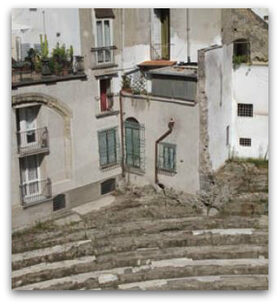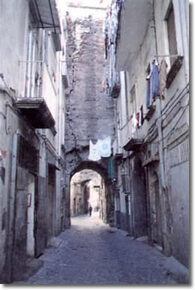
- Via Anticaglia
From largo Regina Coeli, where the Convent of Santa Maria Regina Coeli with its paintings by Stanzione, Luca Giordano and Micco Spadaro stands, we continue along via Pisanelli. As we pass beneath the church's octagonal bell tower, we see on the left the 17th-century Monastery of S. Maria di Gerusalemme, knowon as the "church of the Thirty-three", which was the number of nuns who were there in seclusion.
In the nearby via L. Armanni stands the building the hospital of Santa Maria del Popolo degli Incurabili, founded in the 16th century, and the splendid 18th-century Pharmacy.
Via Anticaglia (which means "ancient monument") takes its name from the 2nd century AD arch-shaped earthenware structures which are the buttresses of the Roman Amphitheatre's auditorium, where even the Emperor Nero performed. The open-air theatre and the Odèion are in the area between via Anticaglia, via San Paolo and the Convent of S. Paolo Maggiore. Palazzo Avellino stands in the square with the same name; it was built at the end of the 14th century for Ottino Caracciolo, Prince of Avellino, and enlarged in the 17th century.
We reach via Duomo, one of the ancient reference-points of the city which takes its name from the imposing Cathedral, where numerous masterpieces of art are kept and where the miracle of the liquefaction of the blood of San Gennaro, or St Januarius, takes place on September 19th.
The largo, or square, where the 15th-century Palazzo dell'Arcivescovado finds, takes the name Donnaregina from the Baroque church which stands just before the other 14th-century church with the same name.
We go on to the Church of the Santissimi Apostoli, founded in the 5th century in the site of a pagan temple.
At the end of via Carbonara, which laid outside the Angevin walls and was used as a rubbish dump during the Middle Ages and then as a joisting and tournament place, there is the building of San Giovanni a Carbonara, an impressive example of Renaissance sculpture. It stands at the top of a theatrical-looking stairway of elliptical form designed by Sanfelice.
